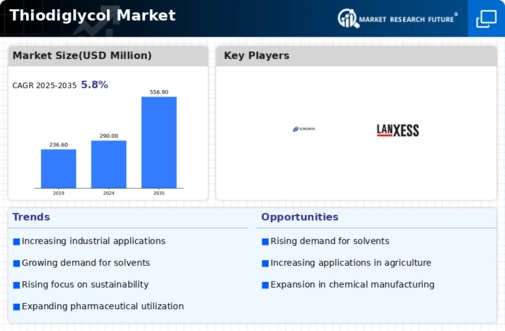Market Trends
Key Emerging Trends in the Thiodiglycol Market
The Thiodiglycol market has been witnessing significant trends in recent years, reflecting shifts in demand, regulatory landscapes, and technological advancements. Thiodiglycol, a key chemical compound primarily used in the production of chemical warfare agents, as well as in various industrial applications such as dyes, pigments, and plasticizers, has seen notable market trends influencing its dynamics.
One prominent trend in the Thiodiglycol market is the increasing focus on safety and environmental regulations. With growing concerns over chemical safety and environmental sustainability, regulatory bodies worldwide have been imposing stricter regulations on the production, handling, and usage of Thiodiglycol and related compounds. This trend has prompted manufacturers to invest in cleaner production processes, develop safer alternatives, and adhere to stringent compliance standards. Companies operating in the Thiodiglycol market are thus compelled to prioritize sustainability and environmental responsibility in their operations.
Another significant trend shaping the Thiodiglycol market is the rising demand from end-use industries such as textiles, paints and coatings, and pharmaceuticals. Thiodiglycol's versatile properties make it an essential ingredient in various industrial processes. In the textile industry, it is used as a solvent and dyeing assistant, while in the paints and coatings sector, it serves as a key component in formulations for its excellent solvency and viscosity properties. Moreover, the pharmaceutical industry utilizes Thiodiglycol in the synthesis of certain pharmaceutical compounds. The increasing demand from these sectors is driving growth in the Thiodiglycol market.
Furthermore, technological advancements are playing a crucial role in shaping market trends for Thiodiglycol. Continuous research and development efforts are focused on enhancing production efficiency, exploring novel applications, and improving product performance. Advanced manufacturing techniques, such as catalytic processes and green chemistry methods, are being employed to optimize Thiodiglycol production, reducing energy consumption and minimizing environmental impact. Additionally, innovations in formulation techniques and product customization are enabling manufacturers to cater to specific requirements of end-users, thereby expanding their market presence and competitiveness.
Moreover, the globalization of trade and supply chains is exerting a significant influence on the Thiodiglycol market. Increasing international trade agreements, coupled with the growing demand for Thiodiglycol in emerging economies, are driving market expansion and diversification. Companies are strategically expanding their distribution networks and establishing partnerships with local distributors to tap into new markets and gain a competitive edge. Additionally, the evolving geopolitical landscape and trade policies are factors that companies in the Thiodiglycol market closely monitor to navigate potential challenges and opportunities.
On the other hand, fluctuating raw material prices and supply chain disruptions pose challenges to the Thiodiglycol market. The availability and cost of key raw materials used in Thiodiglycol production, such as ethylene oxide and sulfur, are subject to market volatility and geopolitical factors. Consequently, manufacturers face uncertainties in procurement and pricing, which can impact their profitability and competitiveness. To mitigate these challenges, companies are adopting strategies such as vertical integration, diversification of suppliers, and proactive risk management.





Leave a Comment